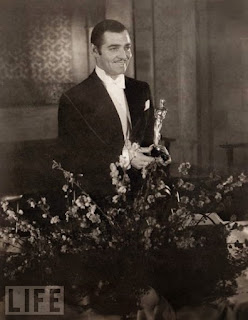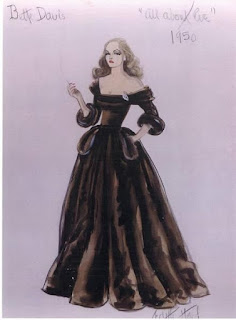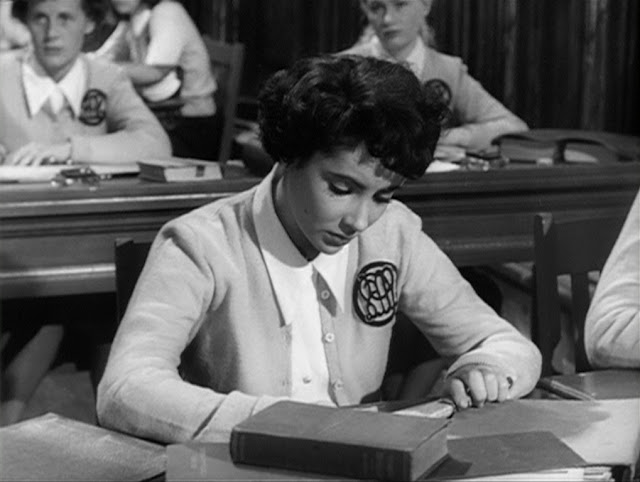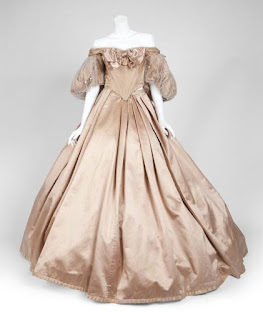The category for Costume Design at the Academy Awards came rather late - 1949 (for movies released in 1948). The Awards had already been going on for 20 years without any recognition to the talented people who designed the clothes that women and men alike coveted and that transported the viewer to another time and place, or at least, away from their dreary existence as the films of the 1930s did or from violence and war in the 1940s. (You can fix this by voting on the sidebar => for Best Costume Design for the years 1929 to 1948. Click the photo of Scarlet O'Hara at the top for more info.)
Naturally, every costume designer in Hollywood was delighted when a category just for them was announced. Since the Awards were so well established by then, and the suspense that the use of the Envelope brought, it made it all the more exciting.
*I have not seen all of these films so if you see a costume that doesn't belong please let me know.
1949
That first year, at the 21st Academy Awards, only four films were nominated (as opposed to ten in later years). The award was divided into two sub-categories: Best Costume Design in Black and White and Best Costume Design in Color with black & white costumes being typically contemporary and color costumes being from historical epics and musical spectacles.
For black and white, Irene Lentz was nominated for
B.F.'s Daughter (starring Barbara Stanwyck) and Roger K. Furse for
Hamlet (Elizabeth Hennings is the uncredited designer, Furse is listed as designer under Art Dept.).
Hamlet, which starred Laurence Olivier, won.
For color the suspense was especially high. Edith Head and Gile Steele were nominated for
The Emperor Waltz, a film Head considered her best so far. But she was doomed to disappointment when Dorothy Jeakins and Barbara Karinska took the award for
Joan of Arc. After that, Head never let her hopes get that high again.
1950
The following year Edith did win her Oscar (first of eight and most of any costume designer) for
The Heiress staring Olivia de Havilland and Montgomery Clift. The costumes not only had to be period correct, but also give insight into the characters. For de Havilland, Edith made the costumes a little ill-fitted or a little too showy to convey her insecurities. It is only near the end of the film that her dresses becomes perfect, showing the end of her personal journey of overcoming her timidness and insecurities.
(I started making slideshows for each film but it was taking too long to load)
In the color category, Errol Flynn's film (and Olivia's frequent co-star),
Adventures of Don Juan with costumes by Marjorie Best, Leah Rhodes, and William Travilla won.
1951
All About Eve, Bette Davis's "comeback" film, won another Oscar for Edith Head the following year. The famous brown evening gown was a happy accident. The neckline was supposed to be square, but some mis-measurements caused the sleeves to slip off the shoulders. Davis made it work, as there was no time to fix it. It became an iconic gown.
Anne Baxter and Bette Davis in the same costume (Baxter sans wig)
Charles LeMaire's designs for a young Marilyn Monroe in a small part
Cecil B. DeMille's biblical epic,
Samson and Delilah won in the color category. The film was costumed by many designers (that way DeMille HAD to be in charge so that the costumes would be seamless). The credited costume designers were Edith Head, Charles LeMaire, Dorothy Jeakins, Elois Jenssen, Gile Steele, and Gwen Wakeling. Head designed the costumes for the leading lady, Hedy Lamarr. The peacock dress is one of the most famous in movie fashion history. DeMille purported to have collected all of the peacock feathers himself from his peacock farm. In reality it was several assistants running around.
The real peacock feathers are on the cape only. The bodice is beaded.
Angela Lansbury
1952
Edith won yet another Oscar for
A Place in the Sun starring Elizabeth Taylor and Montgomery Clift (if this is starting to sound like a timeline of Edith Head, I apologize. I DID just finish reading "Edith Head's Hollywood" - hence all the background stories). Taylor's white dress has since become an icon and was copied by the thousands for prom dresses that year.
Taylor, Clift, and Shelly Winters on the set
Orry-Kelly, Walter Plunkett, and Irene Sharaff won in the color division for
An American in Paris starring Gene Kelly and newcomer Leslie Caron. The dance/dream sequences give an opportunity for unique costumes.
This is my favorite. I love stars on dresses!
1953
Helen Rose won her first Oscar for the film
The Bad an the Beautiful starring Lana Turner and Kirk Douglas.
That's Barbara Billingsley in the dark dress (June Cleaver).
The color award went to Marcel Vertes for
Moulin Rouge starring Zsa Zsa Gabor.
1954
In 1953, Audrey Hepburn stepped gracefully into the scene and swept the fashion world (and everybody else) off their feet. Her first film,
Roman Holiday, was costumed by Edith Head and took the award for black and white costume.
Same outfit styled two ways.
Audrey liked this dress so much she had the bodice re-done and wore it to
the Oscars (below), where she won for Best Actress.
The Robe, starring Richard Burton and Jean Simmons and with costumes by Charles LeMaire and Emile Santiago, won for color costumes.
1955
The following year Edith Head won the Oscar for another Audrey Hepburn film,
Sabrina. The thing is, Head only designed some of Hepburn's costumes (the "before France" look, the sailing outfit, and the black slacks and shirt). Hubert de Givinchy designed all of the iconic gowns in the film but was not credited, nor did Head acknowledge his work in her acceptance speech... but that's a different post (
Silver Screen Modes has an excellent post). These costumes won no matter who designed them.
You can purchase a replica of this iconic gown
here.
A Japenese film,
Gate of Hell, won in the color division with costumes by Sanzo Wada.
1956
Helen Rose's costume's in I'll Cry Tomorrow starring Susan Hayward won in the black and white category.
Love is a Many-Splendered Thing starring William Holden and Jennifer Jones, with costumes by Charles LeMaire won in the color category. The film is set in Hong Kong.
1957
The Solid Gold Cadillac, starring Judy Holliday and with costumes by Jean Louis won black and white.
The King and I starring Deborah Kerr and Yul Brynner won in the color category with it's extremely large skirts and that iconic "Shall We Dance" dress designed by Irene Sharaff.
I wonder how wide this dress was exactly?!
1958
For the next two years there was no distinction between color and black and white films. The Best Costume Award for a film made in 1957 was the color film Les Girls with costumes by Orry-Kelly. There's lots of matching costumes going on.
Gene Kelly, Mitzi Gaynor, Kay Kendall, and Tanya Elg
1959
Gigi, starring Leslie Caron and Louis Jourdan won the following year with costumes by Cecil Beaton.
1960
The next year went back to the two category format. This lasted until 1967. The black and white award went to
Some Like it Hot starring Tony Cutris and Jack Lemmon (in drag) and Marilyn Monroe. Orry-Kelly did the costumes.
Can you tell who's who?
Joe E. Brown & Jack Lemmon
The sweeping historical epic,
Ben Hur starring Charlton Heston, won with costumes by Elizabeth Haffenden.
To see a list of all of the films that won Best Costume after 1960,
click here.
This post is for the
31 Days of Oscar Blogathon hosted by
Once Upon a Screen,
Outspoken & Freckled, and
Paula's Cinema Club. Each week is devoted to different catergory:
Week 1 - The Actors,
Week 2 - Oscar Snubs,
Week 3 - The Crafts, and
Week 4 - The Motion Pictures and the Directors. Be sure to visit each blog to view all of the different categories.


























































































































































































